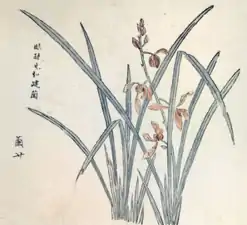Flowers of the Four Seasons
The Flowers of the Four Seasons (Chinese: 四季名花; Vietnamese: Tứ quý danh hoa; Japanese: 四季の花) are a group of flowers found in Chinese, Japanese and Vietnamese art and culture which represent the four seasons, consisting of the orchid (spring), the lotus (summer), the chrysanthemum (autumn) and the plum blossom (winter). They contain three of the elements of the Four Gentlemen.[1][2][3][4][5][6]
Gallery
 Plum blossoms (contemporary)
Plum blossoms (contemporary) Orchid - Hu Zhengyan (1633)
Orchid - Hu Zhengyan (1633) Chrysanthemums from the Xian'e Changchun Album by Giuseppe Castiglione (1688-1766)
Chrysanthemums from the Xian'e Changchun Album by Giuseppe Castiglione (1688-1766) "Elegance of Lotus Looking from Heaven" (contemporary)
"Elegance of Lotus Looking from Heaven" (contemporary)
See also
References
- Chinese Symbols and Chinese Art Motifs Archived 2010-12-14 at the Wayback Machine. (Retrieved on March 25, 2009)
- article on Chinese painting with the 4 flowers and their symbolism (Retrieved 3-28-2009)
- Google Booksearch scan of Description of Chinese Pottery and Porcelain by Yen Chu, Yan Zhu, Stephen Wootton Bushell, François Xavier Dentrecolles. Translated by Stephen Wootton Bushell. The Clarendon Press, 1910 (retrieved 3-28-2009)
- Encyclopedia of Chinese Symbolism and Art Motives, C.A.S. Williams. New York: The Julian Press (1960). p. 190
- People's Daily Online -- Plum blossom, peony proposed to be national flowers. (Retrieved on March 25, 2009)
- "Birds and flowers of the four seasons, summer - eKokuhou".
Further reading
- Flowers Of The Four Seasons: The Fundamentals Of Chinese Floral Painting, Su-Sing Chow (in English and Mandarin Chinese). Art Book Publishing Co. (1983)
This article is issued from Wikipedia. The text is licensed under Creative Commons - Attribution - Sharealike. Additional terms may apply for the media files.